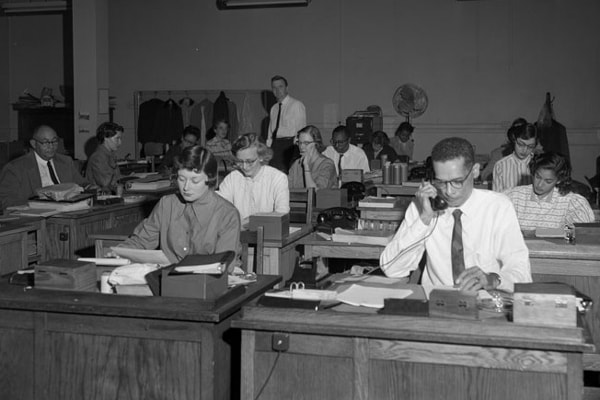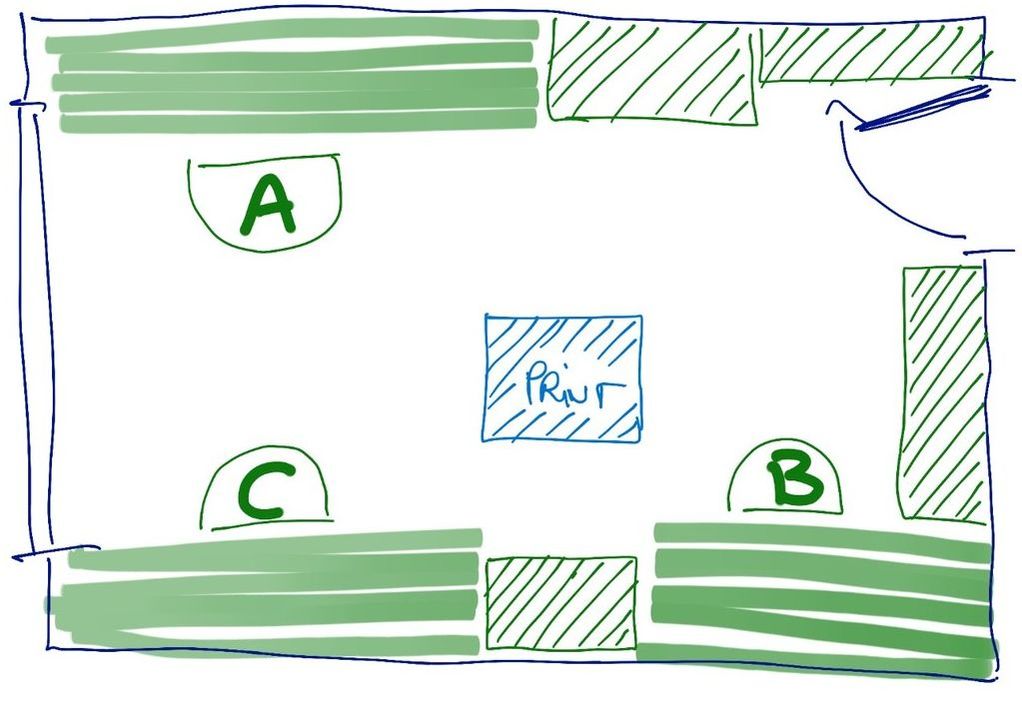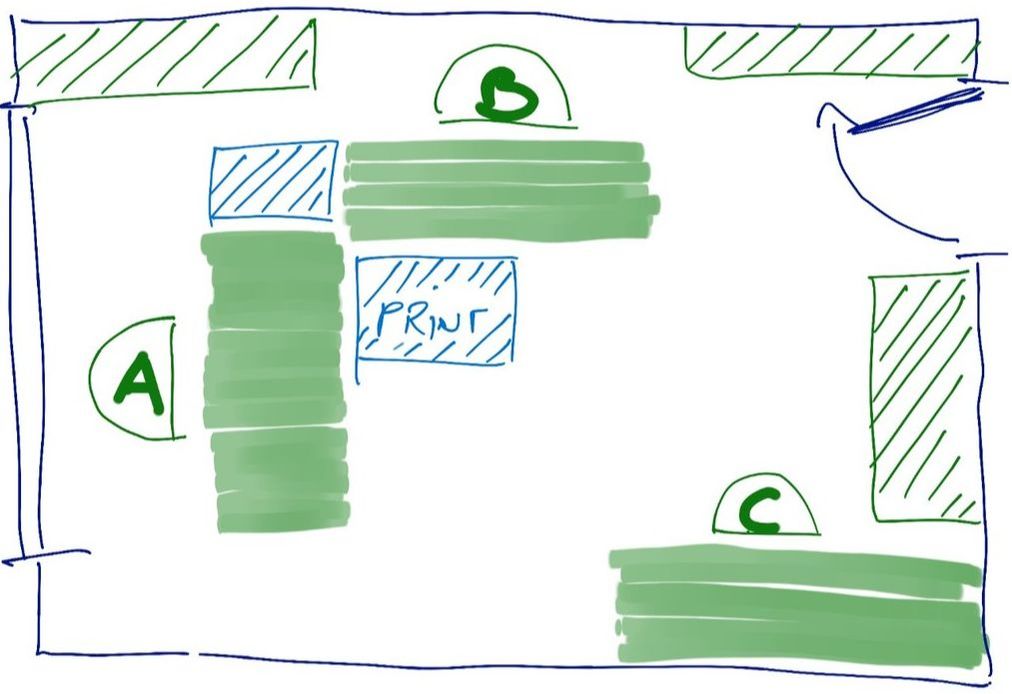Obviously, there can be huge advantages to sitting with others, especially if your work overlaps or you tend to work together on the same projects. Our example shows a level of collaboration between all three on different levels. A lot of the materials you work with can and have to be shared in nature: you’ll have a similar daily routine, maybe go to the same team meetings, come in and leave at roughly the same time, share resources like stationery, tools, workstations, printers, and so on. On the other hand, these common items can also become a point of discontent if one or several of them turn out to be heavily used by all parties concerned and they end up having to wait their turn to use them. If Cindy keeps printing project plans while Bert has letters that need to go out, conflict is pre-programmed. Or Angela having to take confidential calls or working with papers that Cindy is not allowed to see. As you can imagine, these things require a whole lot of consideration, and in the best of worlds, this constellation would never fly… or would it? Surprisingly, a lot of offices, especially small ones, tend to run on the premise that saving on office real estate is a good idea and “we’ll just work around all this”. In our example, if Angela is convinced that this works for her, there is no chance that Bert or Cindy will ever get a different arrangement! Let’s look at some of the contentious elements here: Communication/confidentiality First of all, if there is any doubt whatsoever that essential confidentiality could be breached, having those three people in one room should be avoided at all cost. Either of those three people could be exposed to confidential information during their work, and although Angela appears to be the big boss person here, and should be aware of all that is going on, there are HR-related things that need to remain confidential, and PA related stuff that Bert is doing for others that Angela should not be exposed to (think: legal or personal stuff). Imagine Bert having to communicate on the phone with the other people he works for, constantly interrupting Cindy and Angela’s workflow. However, even in this arrangement of people, this is not necessarily an issue. With proper care, why not? Dealing with confidential paperwork can be a little challenging, but as long as everyone makes sure their confidential papers are carefully stored away at all times, things may just work out. Shared resources I’ve already pointed out that shared resources earlier on, and you can see why this is the main reason for offices being arranged this way, with multiple people sharing space and resources. That is certainly the way to go, but there is a spatial element to sharing resources: they have to be accessible to all without becoming an inconvenience to the others. What if Bert is in charge of the stationery cupboard and when he is away nobody can get a replacement for their broken stapler? Or Cindy has to move each time anyone needs a notebook from the cupboard behind her desk? The placement of furniture can play a huge role in the usefulness of the space and the general sense of contentment. As long as everyone in the room can honestly say “yes, this works for me”, everything is going all right. Space allocation That brings us to furniture arrangements. In any shared space scenario, the best way to make use of the available space is usually having desks along the walls with everyone’s back to the centre, storage (cupboards or shelves) along the walls as well, and the shared resources somewhere central.
Let’s assume Angela gets her view into the room and towards the door, here is another scenario that could possibly work. As you can see, the space isn’t nearly as well used as it could be with everyone facing the wall, but this is pretty much the standard layout for this situation in my own experience.
Sharing offices can have advantages, especially if the occupants of the room work together most if not all the time. As soon as the work assignments start to vary more than a little, and confidentiality becomes more than just an inconvenience, it should be obvious that the arrangement no longer serves the purpose of streamlining the office – it creates additional issues that could be avoided by a level of rearrangement.
It all depends on an understanding of the needs and requirements, restrictions and advantages of each person involved. It pays to take a good look at classic setups, or setups in offices you visit, and taking a moment to consider the advantages and limitations of each before setting up your own office space. It’s a highly sensitive and important decision that tends to be taken very quickly and solely based on the available space, the notion that renting one less room is financially more interesting (but ultimately costs a lot of time and effort), or – worst of all – not giving much thought to these matters in the first place. My advice is this: take a step back and evaluate the space from the point of view of each of your collaborators independently. What do Angela, Bert or Cindy really think of the arrangement? Knowing their thoughts doesn’t oblige you to make any changes, but it could very well inform future decisions when a reshuffle becomes necessary. Comments are closed.
|
Ask the ClutterMeisterIdeas to help clear away the mess in your homes and in your minds.
Feel free to share any of my posts, but please put in a backlink to the original blog post. Thank you. The author
Hi, my name is Tilo Flache. My mission: help clients declutter mind and space.
This blog contains pointers for your journey towards a happier living experience. Archives
November 2023
|





 RSS Feed
RSS Feed




